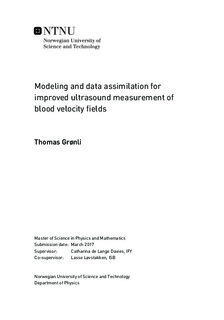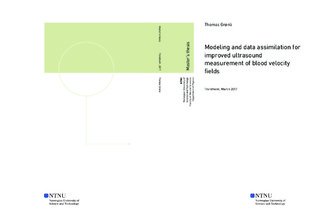| dc.contributor.advisor | Davies, Catharina de Lange | |
| dc.contributor.advisor | Løvstakken, Lasse | |
| dc.contributor.author | Grønli, Thomas | |
| dc.date.accessioned | 2017-04-27T14:08:58Z | |
| dc.date.available | 2017-04-27T14:08:58Z | |
| dc.date.created | 2017-03-05 | |
| dc.date.issued | 2017 | |
| dc.identifier | ntnudaim:16124 | |
| dc.identifier.uri | http://hdl.handle.net/11250/2441153 | |
| dc.description.abstract | Cardiovascular disease is the leading cause of death worldwide, and echocardiography stands as a fundamental tool in assessing congenital or developed heart failure.
A cornerstone of echocardiography is the ability to obtain robust quantitative and qualitative blood flow measurements with methods such as pulsed-wave Doppler or color flow imaging and the development of these techniques has had a major impact on the quality of cardiovascular diagnostics worldwide.
Modern vector flow imaging has opened the estimation of 3D intracardiac blood motion providing a detailed map of the flow structures inside a beating heart.
However, vector flow imaging techniques suffer from limited signal-to-noise ratio, and the overall accuracy is highly sensitive to noise corruption in the measurements, decreasing the overall robustness of these methods.
In this project we investigate the possible benefits of using a model-based filter to improve the quality of blood flow estimates through data assimilation by a full numerical simulation of blood motion based on the Navier-Stokes equations. We implement a Smoothed Particle Hydrodynamics simulator suitable for intracardiac flow conditions to perform the forecast stage of the assimilation cycle.
The model was evaluated towards a computational fluid dynamics phantom and showed comparable fields when attempting to forecast the phantom flow.
Finally, the model was compared to a static regularisation based on a penalised B-spline grid and was found to be of comparable performance.
We conclude that the obtained particle simulator is plausibly fit to model blood motion in a data assimilation context and is ready to be employed as system dynamics in an information fusion filter capable of operating under arbitrary dynamics such as the extended or unscented Kalman filter. We hypothesise that this application will improve the quality of such filters compared to simpler models seen so far. | |
| dc.language | eng | |
| dc.publisher | NTNU | |
| dc.subject | Fysikk og matematikk, Teknisk fysikk | |
| dc.title | Modeling and data assimilation for improved ultrasound measurement of blood velocity fields | |
| dc.type | Master thesis | |

